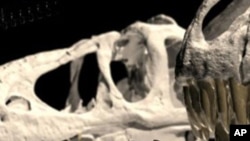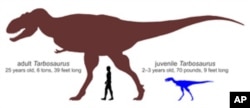Analysis of the youngest and most complete dinosaur skull of any species of tyrannosaur finds significant differences between the young and old of the same species.
Discovered in Mongolia in 2006, the 29-centimeter-long skull - part of an almost complete skeleton that’s missing only the neck and a portion of the tail - was identified as a two-to-three year-old Tarbosaurus. It is a close relative of the North American Tyrannosaurus Rex, a giant, meat-eating predator that lived 70 million years ago.
CT scans from Lawrence Witmer’s laboratory at Ohio University College of Osteopathic Medicine in Athens, Ohio showed structural differences between the youthful predators and their fearsome elders. "What we see is a relatively delicate skull, a skull that wouldn’t have been able to withstand the kinds of thrashing about and powerful sorts of movements that the adults have. So what this animal must have done is have a very different kind of hunting strategy."
Witmer says the skull points to a dramatic shift in lifestyle between the youth and adult reptiles. While the adults wielded power and size to kill large prey, Witmer says the young were agile and dexterous creatures able to fend for themselves.
"One thing that we see in other tyrannosaur species is evidence that maybe some of these young animals actually palled around in groups of juveniles - sort of rambling gangs of young tyrannosaurs - potentially even avoiding the adults."
Witmer says the young skull opens a window into a world far more complex than previously thought.
"It gives us a more sophisticated picture of what the ecosystems were like, in terms of who was eating whom. In the past we might have said, 'Tarbosaurus as a species was the one predator' and we would characterize it as we perceive it as the adult. What we can now think about is that Tarbosaurus actually presented in a sense, multiple kinds of predators."
Witmer expects the young Tarbosaurus skull to reveal more secrets. He and colleagues at Ohio University are now working on reconstructing a model of the dinosaur’s brain, which could provide further insights into its predatory skills.













